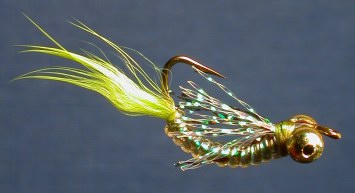Invicta Flies - Spanish Dancer
Huh? This is a trout streamer, you ask? Yep. Like many other patterns, the Spanish Dancer was designed with something completely different in mind (namely deep, slow fishing for panfish). It does a moderate job there, but in an act of "I-wonder-how-this-will-do," it's true calling was revealed, and it hasn't looked back since. Various components such as the hook style, bead chain eyes, and tail make the fly "dance" as it drops toward the bottom on a dead drift, as well as during the retrieve. Lots of flash, lots of minnow-like action, and rock-hopping hook-point-up design all make this a great river pattern that entices big, hungry trout. Use a Non-Slip Mono Loop and fish it like any other streamer, letting it fall near the bottom occasionally, and retrieve with short, erratic, two-four inch strips. Chartreuse has been the most productive color so far, but experiment to see what other colors your local trout prefer.

Hook: Mustad 37160, #10-14
Thread: 3/0 Waxed Monocord, olive
Tail: chartreuse rabbit fur
Underbody: pearl Flashabou
Body: half-round vinyl or D-rib, clear, medium
Eyes: gold bead chain
Wing: pearl Krystal Flash
Tying Instructions:
1) Insert the hook into the vice so the shank is curving up, the front half behind the eye horizontal. Attach the thread immediately behind the hook eye. Just behind the "crook" in the shank near the eye, tie on a pair of bead chain eyes with diagonal wraps. Take three or four turns of thread clockwise between the shank and the bead chain to tighten, then wind to bend to a place on the shank as far from the "elbow" as the hook point.
2) Clip a small tuft of chartreuse rabbit fur, remove any excessively long fibers, and even up the tips a bit by "rocking" the hair back and forth. Tie this in on top of the shank at the bend where the thread is hanging. With this portion of the shank at such an extreme angle, the best way to do this is to take a couple turns of thread with the tuft on the near side of the shank, then hold the tips and butt sections to move the hair to the top of the shank. Pull down on the thread to tighten, then take a couple more tight turns to secure. Clip excess hair and continue winding thread forward to about two hook eye widths behind bead chain.
3) Lash down tag end of D-rib on top of the shank (leave D-rib on spool) with tight turns of thread, continuing to the tail with tight, close spiral wraps. Spinning the bobbin clockwise will help strengthen the monocord, allowing for tighter thread wraps if you like. The flat side of the D-rib should be against the shank. At the tail, wind forward again, completely covering the D-rib, to just behind bead chain. Tie in a full strand of Flashabou, wind back over the tied-down D-rib to the tail, the spiral forward over itself back to behind the bead chain. Tie off and clip the excess.
4) Throw a half hitch in the tying thread to secure, then wind the vinyl D-rib forward, making sure the flat side is against the shank. On the curved shank, it's a little helpful to stretch the D-rib on the inside of the curve while wrapping, and relaxing it on the outside (this just helps fill the body out a bit fuller and minimizes any gaps- a technique for picky people like me!). Tie down behind the bead chain eyes and clip or use an exacto knife. Take a few more tight turns of thread to cover any exposed material. Tie another half hitch to secure.
5) Rotate or turn the hook over in the vise. Gather a dozen strands of pearl Krystal Flash and a half dozen strands of peacock Krystal Flash. Blend well and tie in on what is now the top of the shank directly behind the bead chain eyes. Gather all the strands and trim as a bundle so the ends are at the beginning of the tail. Cover any exposed ends at the bead chain. Figure-eight wrap the thread around the bead chain to fill in a little, then whip finish the thread just behind. Clip the thread and cement the wraps around the eyes well.